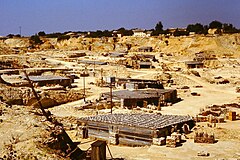
Back Soinhofna Koichstoa BAR Pedra calcària de Solnhofen Catalan Solnhofenský vápenec Czech Solnhofener Plattenkalk German Caliza de Solnhofen Spanish Calcaire de Solnhofen French Solnhofeni litográf pala Hungarian Gamping Solnhofen ID ゾルンホーフェン石灰岩 Japanese Solnhofener kalksteen Dutch
| Altmühltal Formation | |
|---|---|
| Stratigraphic range: [1][2] | |
 Outcrop of the Solnhofen Limestone | |
| Type | Geological formation |
| Underlies | Mörnsheim Formation[1] |
| Overlies | Rögling Formation[1] |
| Lithology | |
| Primary | Lithographic limestone[1] |
| Location | |
| Coordinates | 48°54′00″N 11°00′00″E / 48.9000°N 11.0000°E |
| Approximate paleocoordinates | 40°06′N 19°12′E / 40.1°N 19.2°E |
| Region | |
| Country | |
| Type section | |
| Named for | Solnhofen |
The Solnhofen Limestone or Solnhofen Plattenkalk, formally known as the Altmühltal Formation, is a Jurassic Konservat-Lagerstätte that preserves a rare assemblage of fossilized organisms, including highly detailed imprints of soft bodied organisms such as sea jellies. The most familiar fossils of the Solnhofen Plattenkalk include the early feathered theropod dinosaur Archaeopteryx preserved in such detail that they are among the most famous and most beautiful fossils in the world. The Solnhofen beds lie in the German state of Bavaria (Bayern), halfway between Nuremberg (Nürnberg) and Munich (München) and were originally quarried as a source of lithographic limestone. The Jura Museum situated in Eichstätt, Germany has an extensive exhibit of Jurassic fossils from the quarries of Solnhofen and surroundings, including marine reptiles, pterosaurs, and one specimen of the early bird Archaeopteryx.[3]
- ^ a b c d Rauhut, O. W., Heyng, A. M., López-Arbarello, A., & Hecker, A. (2012). A new rhynchocephalian from the Late Jurassic of Germany with a dentition that is unique amongst tetrapods. PLoS ONE, 7(10): e46839.
- ^ Schweigert, G. 2007. Ammonite biostratigraphy as a tool for dating Upper Jurassic lithographic limestones from South Germany – first results and open questions." Neues Jahrbuch für Geologie und Paläontologie - Abhandlungen, 245(1): 117-125. doi:10.1127/0077-7749/2007/0245-0117
- ^ "Jura-Museum Eichstätt".

